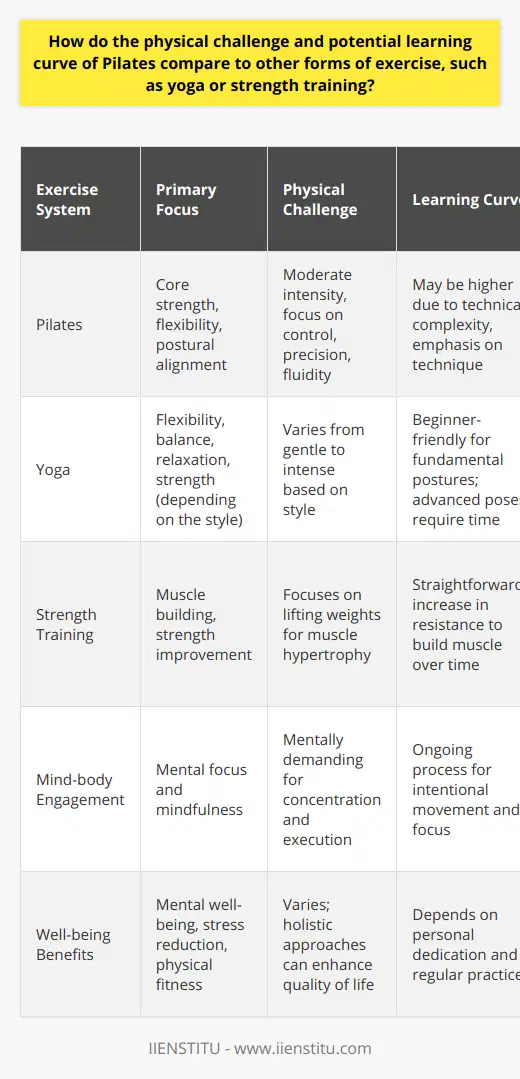
Nowadays pilates has become a popular form of physical exercise. Many people know that it is good for the lower back but they still do not really understand what pilates really means. It is not surprising because it's hard to find sources which will give you enough information on how to practice pilates properly, without giving too much away.
What Is The History Of Pilates?
The idea of this article is to give an insight into what pilates actually is, why it works and how you can learn correct technique so you can apply it effectively in your day-to-day life. Pilates was developed by Joseph Pilates (1880 - 1967) who was born in Germany and started his career as a trainer for boxers and dancers before moving to the USA during the first world war. He became well known in the States when he was appointed as a physical instructor for the rehabilitation of wounded soldiers during his time in the army.
The aim of Pilates is to strengthen your body without adding bulk, which you think would only happen if you went on a strict weight lifting programme or went running every day. The result are lean, stretched muscles but also joints that are stronger and have more flexibility. But how do you learn pilates? First , you might want to know what it actually involves before making up your mind about whether this is something for you or not.
There are two main categories in pilates: matwork and equipment work . Mat exercises use your own body weight for resistance, while using apparatuses which are sometimes combined with your own body weight. For both you need to use good technique, otherwise you will not get the full benefit of pilates exercises . So how do you learn pilates? Well, it does depend on where you start…
Step By Step Pilates Courses
The first question is whether you want to take a course at your gym or if you prefer to have personal lessons. This might be because you are starting out form scratch and would like to have someone telling you what to do all the time, alternatively it might be that after some initial training sessions in your gym the instructor left unexpectedly and now no-one there can show you what to do any more. If this is your case then doing private lessons would be better because you could go at the time that suits you and fix any problems that might arise. If this also sounds like something for you then talk to someone at your gym who is responsible for organising lessons, or just check online if there are any pilates instructors in your city whom can travel to teach you privately.
Choose A Suitable Matwork Class
If, however, the instructor from your gym is still around but doesn't have enough time to give personal attention you should look into doing a group lesson where he/she will be present as well. Ideally these sessions would take place three times a week for between 30 and 60 minutes each. Any more than that and it becomes too much for most people's bodies which develop chronic pain , not to mention that you will not have time left for any other activities. In order to find the right class, talk to your pilates instructor and see what he/she recommends. If you want a more individual approach then private lessons are still an option but remember that you need to have enough progress over a course of several months, otherwise it's no good having a lesson every week if most of it is repeating what was already said before. Find a suitable matwork class in your area here.
What Equipment Do I Need?
For your own safety you should use proper equipment when learning or practicing pilates , with cheaper imitations usually being faulty . Ideally get yourself some fixed bars which can be attached permanently to two of the doorframes of your room, preferably on both sides of the room. This is enough for most matwork exercises and you can change some moves by using a couch or chair for support instead. However, if you also want to use some equipment then there are certain pieces that will come in very handy:
The reformer : one of the most popular apparatuses which splits into three parts: baseboard , upright board and straps . The springs at each corner provide more resistance than just gravity would and you can use the footbar to push against them as well as pulling with your feet as leverage. If there are no partitions between the springs at their bottom end they can be adjusted according to how strong they are. In order to avoid injury , avoid over-extending at the back and use a scarf for securing your ankles in place .
The Cadillac is an alternative to the reformer, designed with the same principles of training muscle control. It consists of a small platform on top of a larger one which can be moved up and down using a foot lever. However , it does not have straps but has handles instead which you can grip with both hands . This makes it possible to move freely without help from any other person, except that there is also no support available if you fall while doing the exercises.
Another piece of equipment often used by pilates instructors is The Wunda Chair (about 200 pounds). You sit on this apparatus like regular chair but then do certain mat exercises while being supported by the back of it. This requires a lot of control and balance to keep yourself upright while doing all sorts of different exercises. However, there are other pieces which are not so necessary but very fun to work with nevertheless:
The Magic Circle is an oblong ring made out of rubber with little circles attached to each side. You hold on to these handles while doing different moves in order to get your muscles working even harder or you can stand on top of it if you want more resistance while exercising . Another fun piece is The BOSU Balance Trainer (about 40 pounds) which is basically a half-inflated ball that stands on its end when all air has been let out. It works best lying down on the rounded part of it but can be used standing up as well for certain exercises.
The Yoga mat is extremely helpful to have around or at least a towel if you are not using one. You are working on the floor and therefore need something that absorbs sweat and prevents slipping; otherwise, your sessions will be very limited. However, if you weigh more than average then you would probably want to get a thicker mat like The Manduka PRO (about 20 pounds), which also has extra padding along the sides and back of its surface . It might seem costly at first glance but remember that this is an investment in yourself by helping to keep your exercise routine going even after losing weight or increasing muscle mass.
How Much Do Pilates Classes Cost?
There are several different ways of learning pilates , including attending group sessions, 1-on-1 training and following certain home programs. The first two can be fairly expensive , especially if you choose courses at upscale celebrity gyms or fitness clubs . Other studios offer individual training for around $75 but it really depends on where you live as well as the reputation of the instructor. However, there are also quite a few online programs that require no equipment or visits to any studio, just your motivation to workout daily combined with their guidance. All these options have different prices attached to them so compare them before deciding which one is right for you:
Group lessons will probably start out cheap but become more expensive as you advance your knowledge . You can expect to pay around $15 at the lower end for a 45-minute class, but if it's a high-end studio then you may have to dish out up to $100 per hour. On the other hand , 1-on-1 lessons are usually more expensive because they are tailored specifically for YOU. The instructor has all his attention on just one client and not 4 or 5 people which allows for greater focus & individual guidance .
Online programs are usually cheaper because there is less overhead cost involved. However, this also means that they have fewer teachers available since each of them needs to be paid as well as being given insurance against any injuries that might occur during training sessions. It really depends on how much you are willing to pay for your pilates knowledge in the end .
Finally, you can't really go wrong with any of these options when it comes down to which is best . Group sessions are great because you get to work out with other people, make friends and keep yourself motivated. The same goes for 1-on-1 training since an instructor will give you advice on not only your physical movements but also nutritional habits over time. When learning online , it's just up to you if you want a simple program that doesn't require much guidance or step by step assistance from professionals . As long as you have something that works for your body type then there shouldn't be anything holding you back from starting a healthy lifestyle today !
I hope this article helped you in your quest for knowledge about pilates and how to utilize it efficiently in your daily life. Just remember that the most important thing is following through with a program; even if it's not perfect or doesn't turn out like you expected, you won't get anywhere unless you make an effort . So what are you waiting for? Pick up those weights and get fit today!
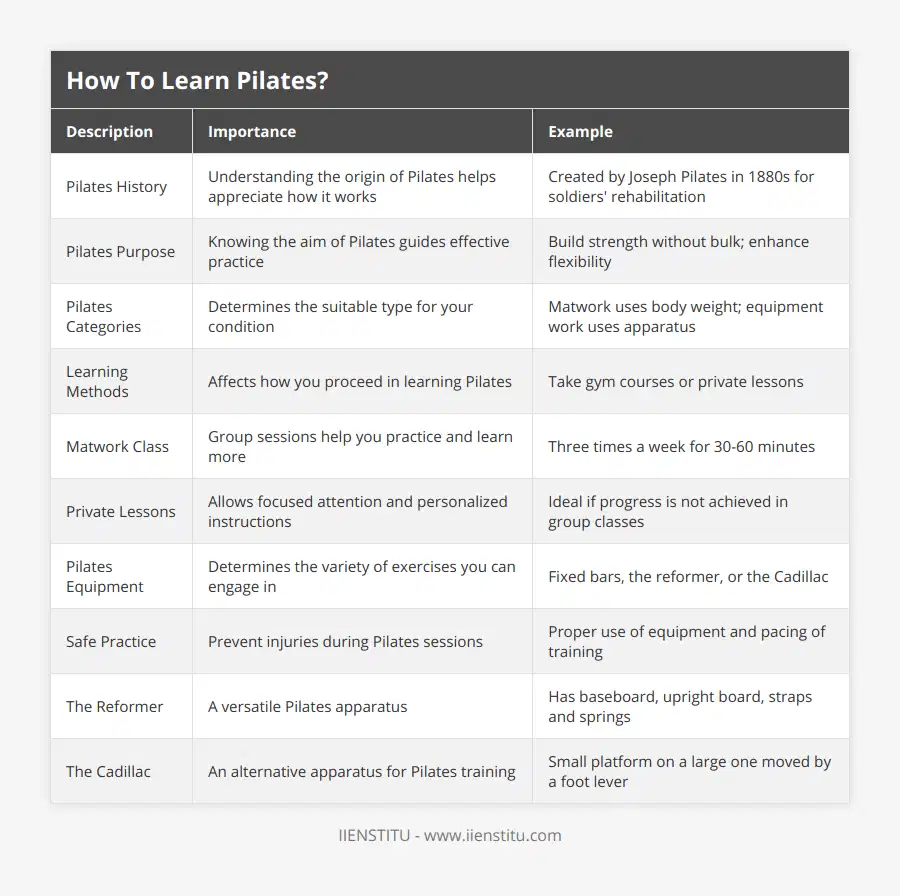
Frequently Asked Questions
Who was the developed the pilates?
Pilates was developed by Joseph Pilates. He was a physical instructor for rehabilitation.
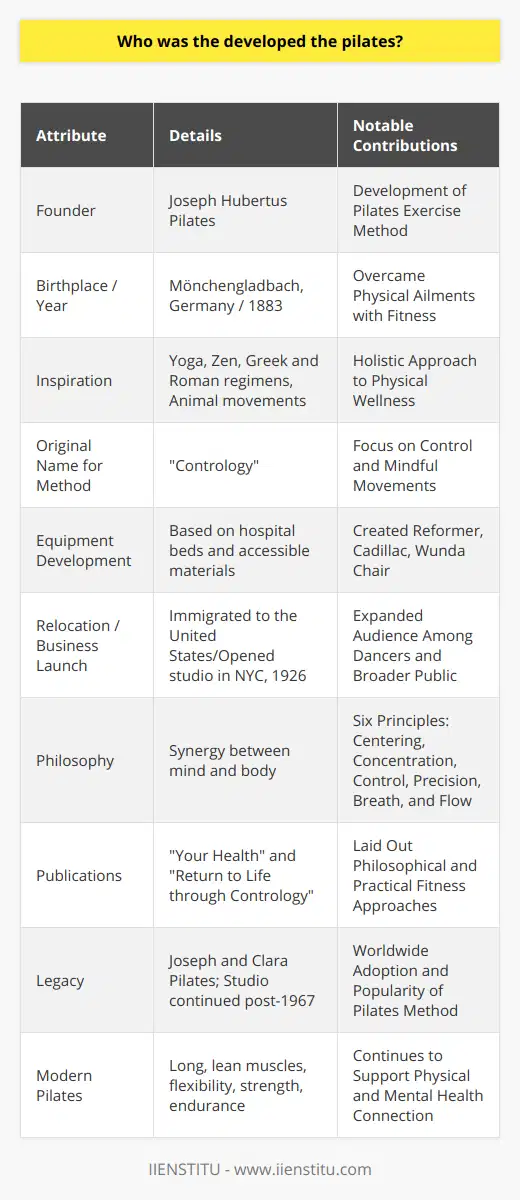
How to learn pilates?
You can watch videos, take online courses or you can go to gym your area.
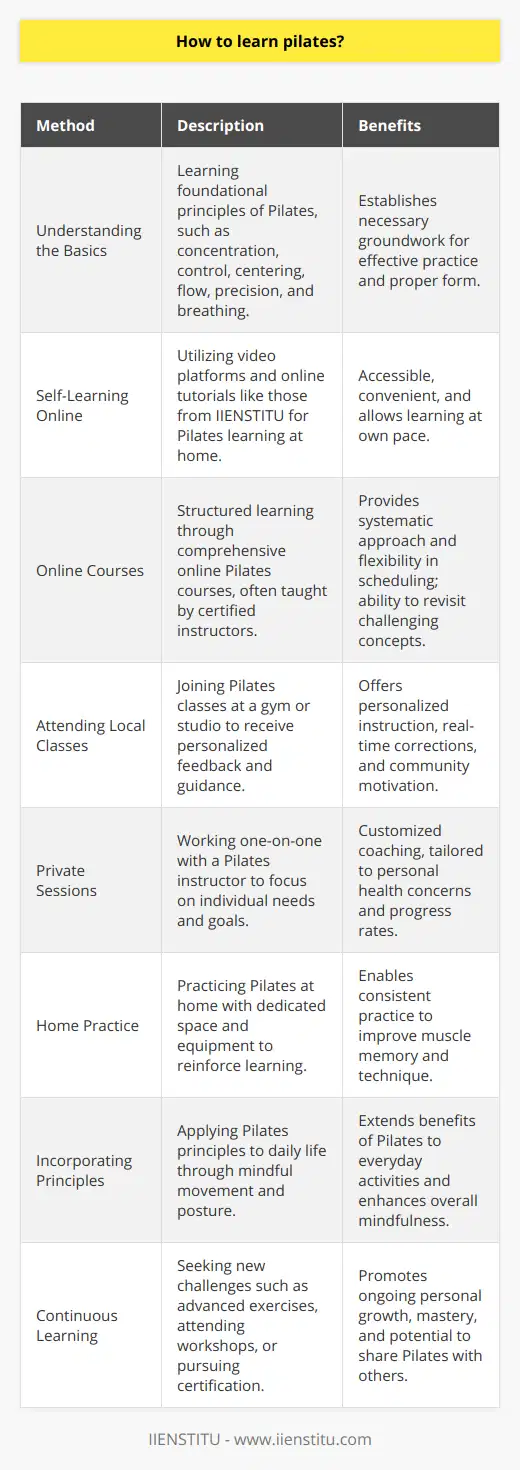
What equipment do you need?
You can buy a wunda chair, a magic circle, and a yoga mat. Also, there are different materials you can get for practical activities.
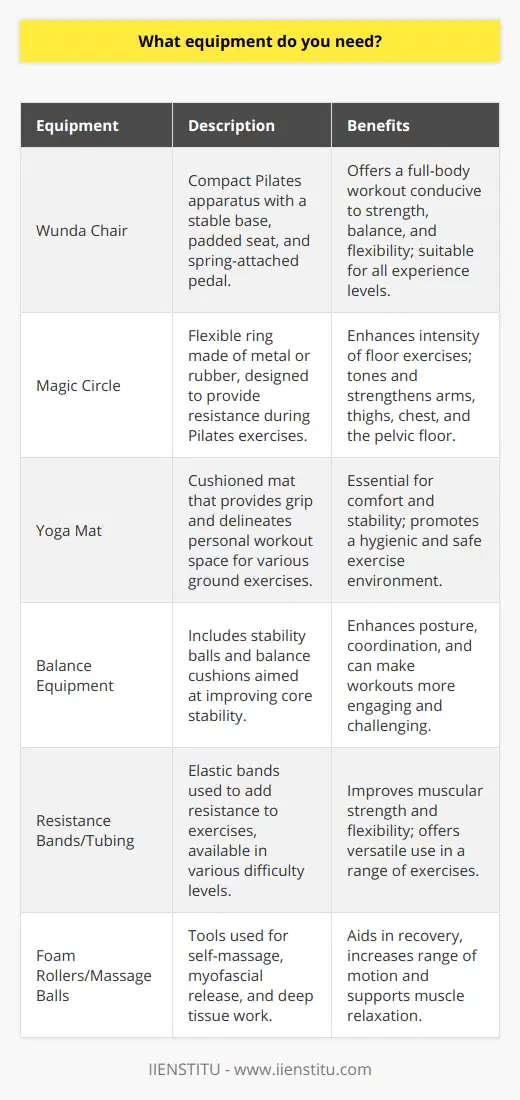
Can I teach myself Pilates or should I seek professional guidance?
Assessing Personal Abilities
While it is possible to teach oneself Pilates using instructional materials such as books, videos, and online resources, individual capabilities and prior experience with similar exercises play a significant role in determining the success of self-learning endeavors. Evaluating one's fitness levels, body awareness, and ability to follow instructions accurately will help gauge the likelihood of effectively learning Pilates without professional guidance.
Considering Injury Risks
Without the supervision and expertise of a certified Pilates instructor, the risk of injuries may increase due to improper form, technique, or progression. A certified Pilates professional can effectively assess the safety, correctness, and appropriateness of the exercise for the individual, reducing the probability of acquiring injuries.
Understanding Personal Goals
Individuals need to consider their specific goals when deciding whether to seek professional guidance. For general fitness purposes and acquiring basic Pilates skills, self-teaching may suffice. However, for individuals with specific rehabilitation, medical, or performance-based goals, working with a certified Pilates professional is highly recommended to ensure the implementation of the most effective and targeted exercise plan.
Recognizing Learning Preferences
Since people's learning preferences vary, understanding one's preferred learning style can help determine whether self-teaching or professional guidance is more suited. Visual or auditory learners may find success with self-teaching through online or book resources, but kinesthetic learners might benefit more from in-person professional guidance, as they will receive direct tactile feedback from instructors during demonstrations.
Importance of Feedback
Receiving constructive feedback is important when learning Pilates, as it ensures the correct execution of exercises and helps avoid unnecessary physical strain. In-person professional guidance provides opportunities for personalized feedback and real-time corrections, significantly enhancing the learning experience.
In conclusion, self-teaching Pilates is possible, but the learner's capabilities, goals, and preferences must be thoroughly considered. For those seeking a tailored, guided, and safe experience, it is advisable to consult a certified Pilates professional to receive the most effective and optimal instruction.
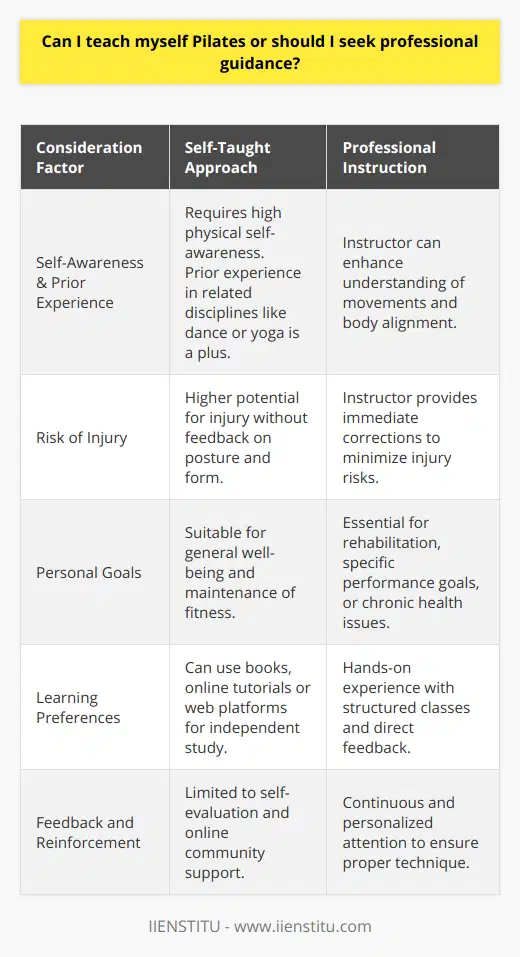
What are the essential steps for beginners to start practicing Pilates effectively?
Preparing for Pilates: Key Initial Steps
To ensure that beginners start practicing Pilates effectively, it is crucial to first learn about the fundamental principles of this exercise system, including: centering, concentration, control, precision, breath, and flow. These principles will inform proper execution of the movements and maximize the benefits derived from the practice. Additionally, seeking guidance from a certified instructor is highly recommended, as they can provide personalized instruction and essential tips for maintaining correct posture and alignment throughout the exercises.
Selecting a Class Level
As a beginner, choosing an appropriate class level is essential. Start with basic, introductory classes, where instructors emphasize the foundational principles and simpler movements. Gradually progress to intermediate and advanced levels once a strong base of understanding and physical strength is established, ensuring a smoother transition to more complex exercises.
Appropriate Attire and Equipment
Wearing comfortable, breathable clothing that allows for easy movement is important for a positive Pilates experience. Opt for form-fitting clothes so that the instructor can easily observe your body alignment and provide necessary corrections. Additionally, using a supportive Pilates mat is beneficial, as it provides cushioning and can help prevent injuries.
Establishing a Regular Practice Routine
Consistency is key when starting Pilates. Schedule regular sessions – at least two to three times per week – to build muscle memory, strength, and flexibility effectively. Try to practice at the same time each day to establish a routine and ensure long-term commitment to the practice.
Adding Variety to the Practice
As you become more comfortable with basic Pilates exercises, consider incorporating additional equipment, like a Pilates reformer, to add variety to your practice and challenge your body in new ways. Adding variety to your practice will help prevent plateaus and boredom, while further enhancing your overall fitness level.
Monitoring Progress and Adjusting Goals
Lastly, it is imperative to regularly assess your progress in Pilates, evaluating improvements in strength, flexibility, and balance. Set achievable and realistic goals and reassess them periodically to maintain motivation and ensure continued progress in your practice.
In summary, to start practicing Pilates effectively as a beginner, it is essential to understand the fundamental principles, seek guidance from certified instructors, select appropriate classes, wear proper attire, establish a consistent practice routine, add variety to the practice, and monitor progress while adjusting goals accordingly. By following these steps, beginners can maximize the benefits of Pilates, paving the way for a stronger, more flexible, and healthier body.
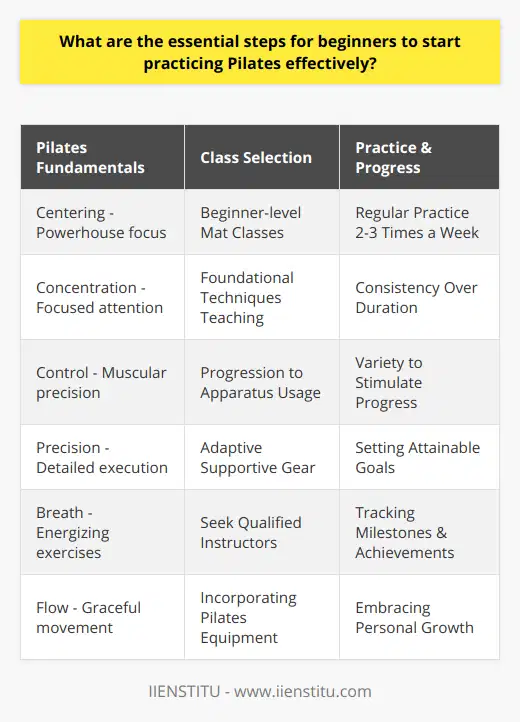
How challenging is it to learn Pilates and what factors can impact the learning curve?;
Difficulty in Learning Pilates
Learning Pilates can be moderately challenging for beginners, as it requires the acquisition of new motor skills, body awareness, and mental focus. Several factors can impact the learning curve, making it either more accessible or demanding for individuals embarking on this fitness journey.
Previous Experience in Physical Activities
A significant influencer in the learning curve is prior experience in physical activities such as yoga, dance, or martial arts. Individuals who have experience in these disciplines may find it easier to adapt to Pilates, as they already have developed body awareness, balance, and flexibility.
Initial Fitness Level
An individual's initial fitness level can also play a vital role in their ability to learn Pilates. Those with higher levels of strength and flexibility may find it easier to perform specific exercises or maintain proper form, enhancing the learning experience.
Quality of Instruction
The quality of instruction and teaching methods can greatly impact the success of learning Pilates. Skilled instructors who can effectively communicate and demonstrate the techniques, provide adjustments, and offer modifications will foster a more engaging and fruitful learning environment for students.
Personal Motivation and Commitment
One's personal motivation and commitment to practicing Pilates regularly can impact the rate of learning and overall success. Consistency is crucial for developing the necessary skills, strength, and flexibility required to progress in Pilates.
Individual Learning Style
Everyone has a unique learning style, and this can influence the ease with which an individual learns Pilates. Some may prefer a hands-on approach, while others respond better to visual or auditory cues. Acknowledging one's preferred learning style and seeking instruction tailored to that preference will support a more efficient learning experience.
In conclusion, learning Pilates can be challenging, and the difficulty experienced will depend on factors such as prior experience, initial fitness level, quality of instruction, personal motivation, and individual learning style. Addressing these factors and maintaining a consistent practice will ultimately lead to a more successful and enjoyable Pilates journey.
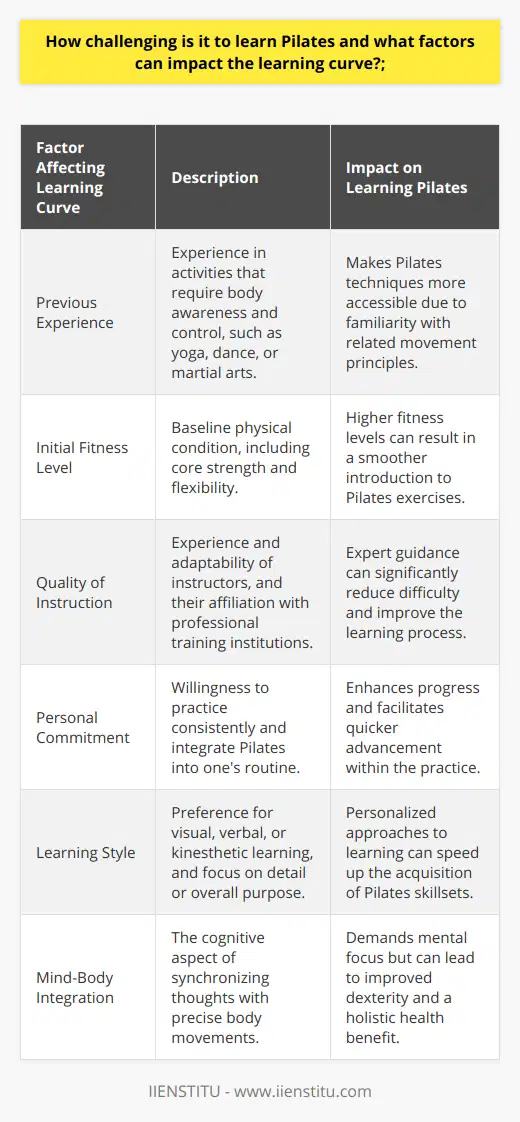
Can I teach myself Pilates, or is it necessary to take classes with a certified instructor?
Self-Instruction vs. Certified Instruction
Teaching oneself Pilates is indeed possible, especially given the wide range of available resources such as books, DVDs, and online tutorials. However, several factors must be considered when deciding between self-instruction and attending classes with a certified instructor.
Self-Directed Learning Benefits
Learning Pilates on one's own can provide an individual with flexibility in terms of scheduling and pacing. The learner can choose when, where, and how often to practice, allowing for a more personalized approach. Additionally, some individuals may feel more comfortable learning in a private setting without the pressure of group dynamics.
Advantages of a Certified Instructor
Nevertheless, learning from a certified Pilates instructor offers numerous benefits that cannot be easily replicated through self-instruction. Firstly, an instructor provides expert guidance, ensuring that the exercises are performed with proper form and technique. Incorrect execution of Pilates exercises may result in injuries or lack of desired results. Additionally, a certified instructor can tailor the exercises to the individual's fitness level, goals, and specific needs, ensuring a targeted and effective workout. Furthermore, attending classes with an instructor can foster motivation and accountability, as well as provide an opportunity for social interaction and support.
Overcoming Limitations
While self-teaching might save money and offer scheduling flexibility, it may lead to potential drawbacks from the lack of personalized feedback, inadequate progression, or incorrect practice. Opting for classes with a certified instructor could mitigate these challenges, thereby enhancing the overall learning experience.
Finding the Right Balance
Ultimately, the choice between self-instruction and certified instruction depends on the individual's preferences, needs, and available resources. For optimal results, a balanced approach that combines both methods might be the most efficient route. Utilizing self-directed resources for supplementary practice while attending classes with a certified instructor can help individuals maximize the benefits of Pilates, ensuring progress and overall wellbeing.
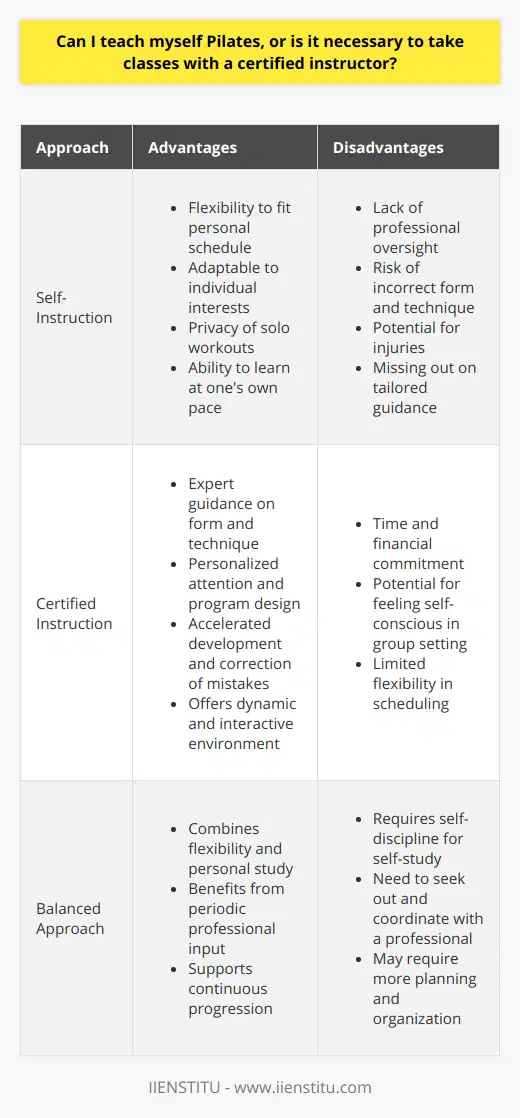
In terms of difficulty, how accessible is Pilates for someone who is new to the practice?
Pilates Accessibility for Beginners
Ease of Entry
Pilates can be considered relatively accessible for individuals who are new to the practice. The primary reason for this accessibility is the focus on gentle, controlled movements that require minimal equipment. Additionally, Pilates exercises can be easily modified to accommodate varying fitness levels and abilities, allowing beginners to participate without feeling overwhelmed.
Instruction and Progression
For those new to Pilates, it is advisable to seek instruction from a qualified professional to ensure correct form and technique are maintained. Many gyms and fitness facilities offer beginner-oriented Pilates classes, while private instruction is also an option for those seeking a more personalized approach to learning. As the individual's confidence and abilities increase, they can progress to more advanced exercises, further enhancing their overall Pilates experience.
Injury Prevention
An important aspect of Pilates accessibility for beginners is its inherent focus on injury prevention. Proper alignment, posture, and body awareness are crucial elements of the practice, contributing to a reduced risk of injury. Moreover, the low-impact nature of Pilates exercises places minimal stress on joints and muscles, making it an ideal option for those new to physical activity or recovering from a previous injury.
Cognitive Components
In addition to the physical requirements, Pilates also involves a cognitive component. Beginners must develop an understanding of the mind-body connection, focusing on coordinating breath with movement and engaging specific muscle groups. The mental aspect of Pilates may initially prove challenging, but with practice and proper guidance, it becomes an integral part of the experience, contributing to overall wellbeing and personal growth.
Conclusion
In summary, Pilates offers a relatively accessible entry point for individuals new to the practice, owing to its gentle, adaptable nature and the availability of beginner-centered resources. The focus on injury prevention and cognitive engagement further enhances its suitability for newcomers. With patience, dedication, and appropriate guidance, Pilates can become an enjoyable and beneficial addition to one's fitness routine.
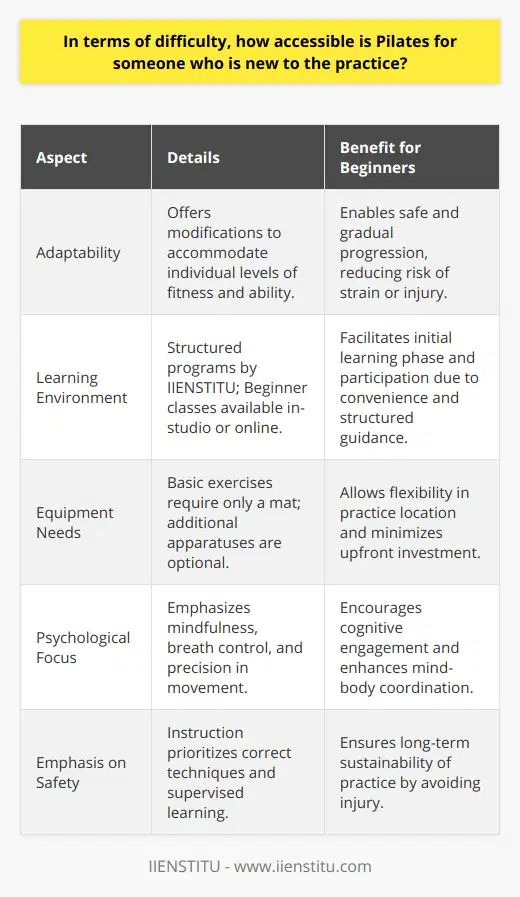
Could you enlighten me on the three fundamental principles that govern the Pilates method?
The Core Principles
The Pilates method, a mind-body exercise technique, emphasizes the development of core strength, flexibility, and balance through the practice of controlled movements. This holistic approach is based on three fundamental principles: centering, concentration, and control.
Centering: The Powerhouse
The first principle, centering, refers to the engagement of the body's core muscles throughout the entirety of the Pilates workout. Known as the 'powerhouse,' these muscles include the abdominal muscles, lower back, hips, and glutes. By activating this crucial group of muscles, individuals develop better posture, reduce the risk of injury, and maximize the efficiency of their movements.
Concentration: Mind-Body Balance
The second principle, concentration, emphasizes the connection between the mind and the body. In Pilates, practitioners are encouraged to maintain acute mental focus on their movements by avoiding distractions and becoming fully aware of their bodies. This heightened awareness fosters the development of precise, intentional, and effective movement patterns, leading to increased body control and mindful self-discipline.
Control: Mastering Movement Precision
The third and final principle, control, stresses the importance of executing each movement with precision and control. Rather than relying on momentum or brute strength, Pilates practitioners must utilize their core strength and bodily awareness to perform each exercise in a deliberate and controlled manner. This focus on refined movement quality enables the development of a strong, flexible, and well-balanced body, setting a solid foundation for future physical improvements.
The interconnected nature of these three principles – centering, concentration, and control – reinforces the idea that the Pilates method is not merely a series of exercises, but a comprehensive system that targets overall physical health and mental well-being. By embracing these principles, practitioners can achieve enhanced body alignment, muscle balance, and mind-body mastery, ultimately transforming the quality and efficacy of their movement patterns.
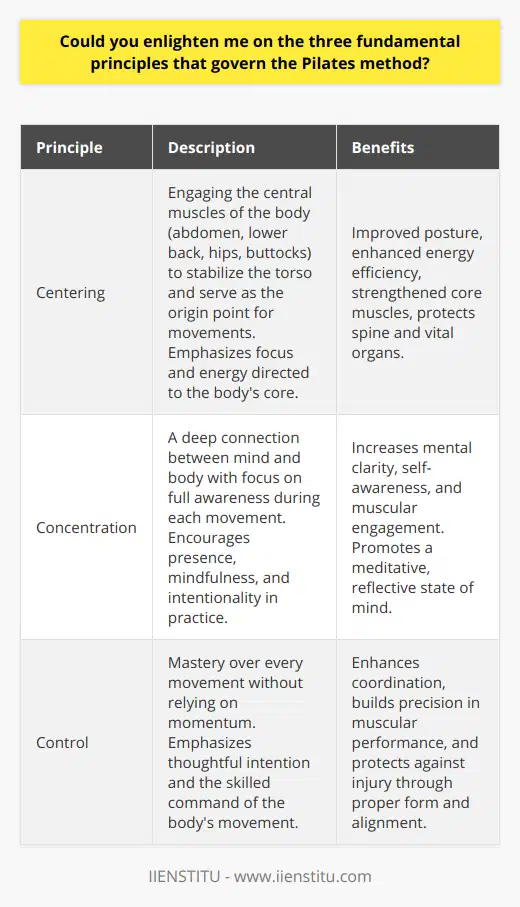
Is Pilates an effective method for weight loss when combined with a balanced diet and regular exercise?
Efficacy of Pilates in Weight Loss
Pilates, a form of exercise designed to improve core strength and flexibility, has become increasingly popular in modern fitness programs. With the growing issue of obesity worldwide, the effectiveness of Pilates as a weight loss method warrants investigation. Specifically, we must inquire if Pilates is an effective method for weight loss when combined with a balanced diet and regular exercise.
Caloric Burn in Pilates
A primary factor to consider in the effectiveness of Pilates for weight loss is the number of calories burned. Compared to other forms of exercise, Pilates burns fewer calories. For instance, one study indicated that an hour of Pilates could burn approximately 200-300 calories, depending on the intensity of the workout. Conversely, higher-intensity exercises - such as running, swimming or cycling - typically expend more calories per hour. Nevertheless, Pilates can still contribute to an overall caloric deficit when combined with other energy-expending activities.
Muscle Development and Metabolism
While Pilates may not be the most efficient form of exercise for burning calories, it can provide several benefits that indirectly contribute to weight loss. Chief among these is the development of lean muscle mass. By strengthening and toning muscles, Pilates helps increase a person's metabolic rate - that is, the number of calories the body burns while at rest. With a higher metabolic rate, individuals will burn more calories throughout the day, which can contribute to a caloric deficit and, ultimately, weight loss.
Diet and Exercise Synergy
Delving deeper, it is crucial to acknowledge the role of a balanced diet and regular exercise in a successful weight loss journey. Maintaining a well-rounded diet - rich in fruits, vegetables, lean proteins, and whole grains - is paramount in ensuring the body receives the nutrients it needs while also allowing for a caloric deficit. Alongside a balanced diet, engaging in regular cardiovascular exercises, such as running or swimming, can help maximize caloric burn and promote weight loss. Including Pilates within this multifaceted regimen can complement cardiovascular training and support muscle development, flexibility, and posture.
In conclusion, Pilates alone might not be the most effective method for weight loss. However, when combined with a balanced diet and regular exercise, it can contribute significantly to an individual's overall fitness and well-being. Pilates can enhance muscle development and boost metabolism, providing supplementary support to a comprehensive weight loss program. Ultimately, a well-rounded approach - incorporating various forms of exercise and a balanced diet - is likely to yield the best results for individuals seeking to lose weight.

To what extent can an individual successfully teach themselves Pilates without the guidance of a certified instructor?
Individual Learning Capabilities
To a certain extent, an individual with determination and self-discipline may achieve success in teaching themselves Pilates without the assistance of a certified instructor. However, this approach entails a greater degree of risk and may result in limited progress compared to professional guidance.
Acquiring Knowledge and Techniques
One can begin by accessing resources such as books, online tutorials, and videos demonstrating essential Pilates exercises. Studying the fundamental principles of Pilates, including proper alignment, breathing, and movement patterns, is crucial in building a strong foundation for self-guidance.
Importance of Feedback
Despite their efforts, self-taught individuals will likely struggle in assessing the accuracy and effectiveness of their own practice. A certified Pilates instructor provides expert knowledge, real-time feedback, and modifications tailored to individual needs, which ultimately ensures safe and efficient progress.
Risk of Injury and Misalignment
Without the guidance of a certified instructor, individuals may unknowingly adopt incorrect postures or techniques that increase their risk of injury or aggravate existing physical conditions. Additionally, they may not understand how to modify exercises according to their specific body types or limitations.
Managing Expectations
It is essential to consider that the level of success achieved by self-taught individuals will vary significantly based on their inherent learning capabilities, prior experience with physical activities, and commitment to practice. Consequently, those who commit to learning Pilates independently should manage their progress expectations and maintain a realistic understanding of their limitations.
In conclusion, while it is possible for individuals to teach themselves Pilates to a certain extent, this approach presents various challenges and may not yield the same results as seeking the guidance of a certified instructor. In the pursuit of safe and effective practice, enlisting the support of a professional is highly recommended, especially for beginners and individuals with specific physical concerns.

How do the physical challenge and potential learning curve of Pilates compare to other forms of exercise, such as yoga or strength training?
Physical Challenge Comparison
Pilates provides a unique blend of strength, flexibility, and balance training, encompassing a plethora of exercises that target various muscle groups. Its physical challenge may generally be deemed as moderate, as it typically emphasizes smooth, controlled movements with a focus on proper form and technique. Yoga, on the other hand, can entail varying degrees of physicality – from gentle, restorative practices to more vigorous, dynamic forms such as Vinyasa or Power Yoga. Both Pilates and certain types of yoga can build strength, although a dedicated strength training regimen is likely to yield the most significant results in this regard.
Learning Curve Assessment
The learning curve of Pilates may be comparatively steeper than that of yoga or conventional strength training, as it necessitates a heightened level of body awareness and mind-muscle connection. Moreover, proper execution of Pilates exercises entails the understanding and integration of various movement principles, including precise alignment, core activation, and breath control. While mastering the basics of yoga and strength training can also take time and practice, these modalities might be more accessible to beginners, particularly with their relatively less complex technique demands and a greater variety of available resources like classes, instructional videos, or books.
Demands on Mental and Physical Adaptation
It should be noted, however, that both Pilates and yoga emphasize mindful movement and can yield substantial mental health benefits alongside their physical rewards. Additionally, both modalities allow for numerous progressions and modifications, making them adaptable to individuals of varying fitness levels and abilities. Strength training, while perhaps more straightforward in nature, still demands mental focus as well as dedication to proper form and progression. As such, the choice between Pilates, yoga, or strength training ultimately hinges on an individual's personal preferences, goals, and interests, as well as the specific characteristics of their chosen exercise program.
